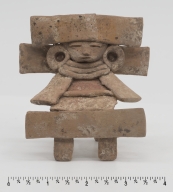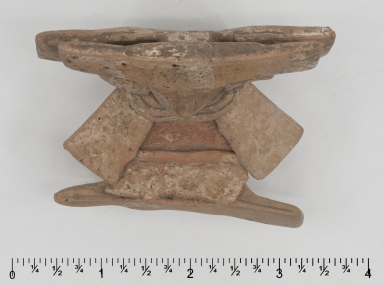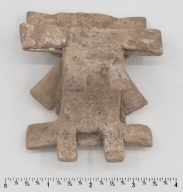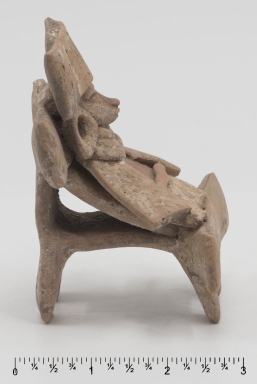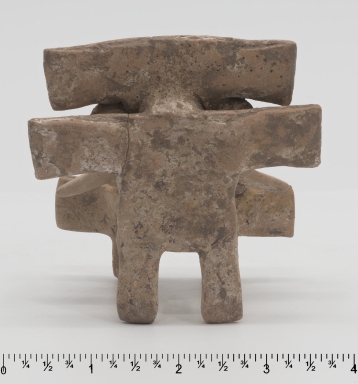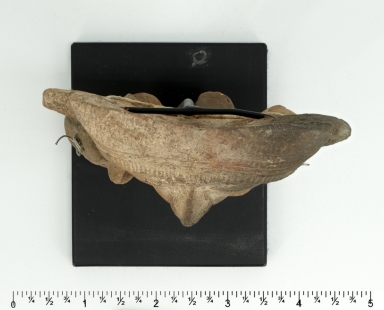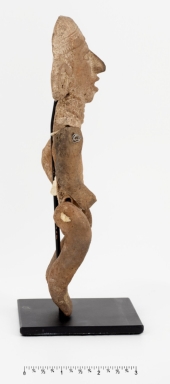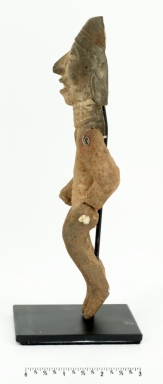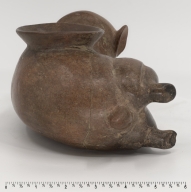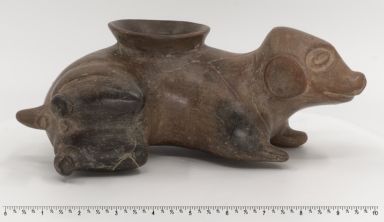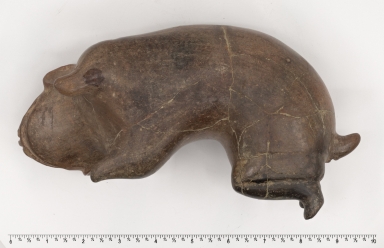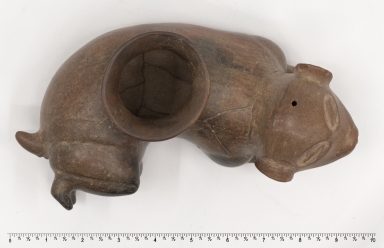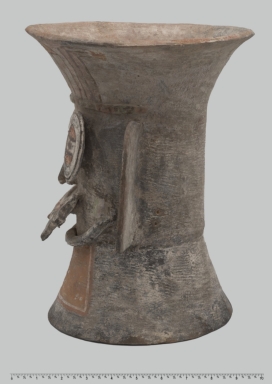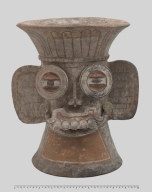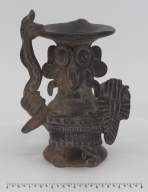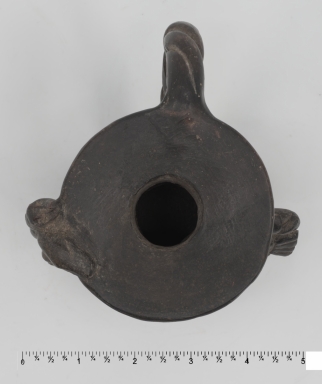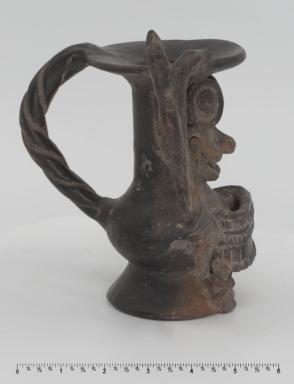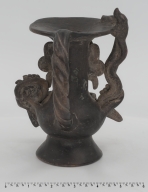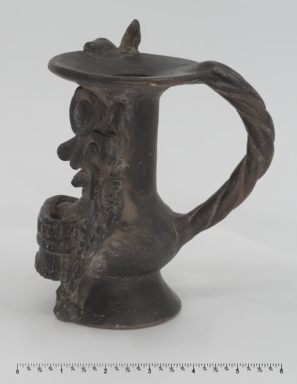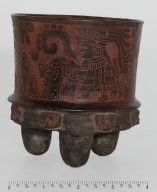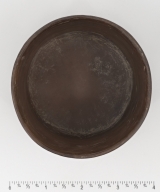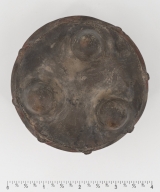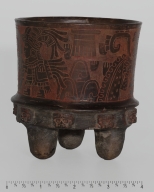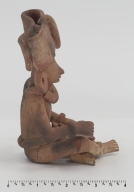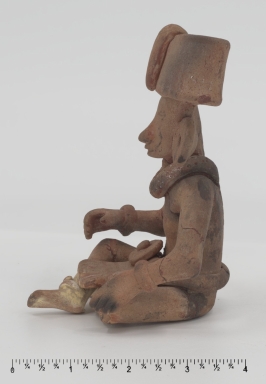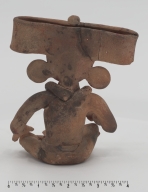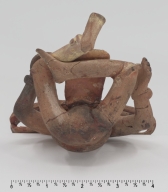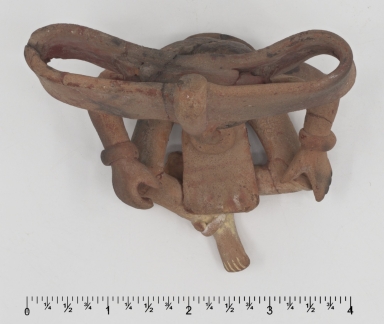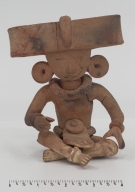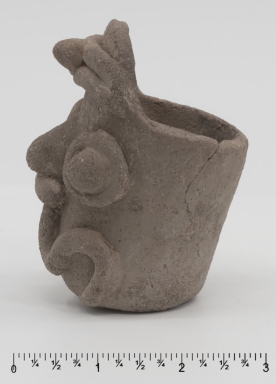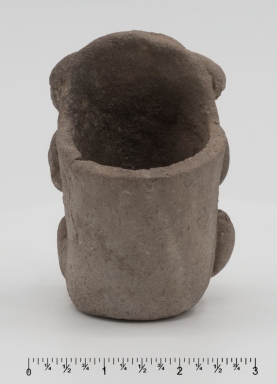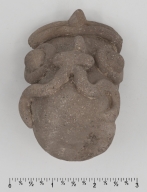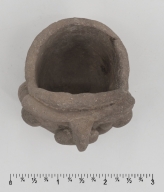|
Title
Small seated enthroned figure.
Description
Human figurines have been handmade at Teotihuacán since 150 BC. Around AD 250, the Teotihuacanos began mass-producing figures using molds. The figurines are not found in burials or temple complexes. The thousands that have been found in residential middens and fills suggest they were important in daily household rituals at the 2000 apartment complexes.
Subject
[Ceramic sculpture--Mexico--Teotihuacán Valley, Art--Mexico--Teotihuacán Valley, Indigenous peoples--Antiquities]
Date
between 150 and 750
Title
Small seated enthroned figure.
Description
Human figurines have been handmade at Teotihuacán since 150 BC. Around AD 250, the Teotihuacanos began mass-producing figures using molds. The figurines are not found in burials or temple complexes. The thousands that have been found in residential middens and fills suggest they were important in daily household rituals at the 2000 apartment complexes.
Subject
[Ceramic sculpture--Mexico--Teotihuacán Valley, Art--Mexico--Teotihuacán Valley, Indigenous peoples--Antiquities]
Date
between 150 and 750
Title
Small seated enthroned figure.
Description
Human figurines have been handmade at Teotihuacán since 150 BC. Around AD 250, the Teotihuacanos began mass-producing figures using molds. The figurines are not found in burials or temple complexes. The thousands that have been found in residential middens and fills suggest they were important in daily household rituals at the 2000 apartment complexes.
Subject
[Ceramic sculpture--Mexico--Teotihuacán Valley, Art--Mexico--Teotihuacán Valley, Indigenous peoples--Antiquities]
Date
between 150 and 750
Title
Small seated enthroned figure.
Description
Human figurines have been handmade at Teotihuacán since 150 BC. Around AD 250, the Teotihuacanos began mass-producing figures using molds. The figurines are not found in burials or temple complexes. The thousands that have been found in residential middens and fills suggest they were important in daily household rituals at the 2000 apartment complexes.
Subject
[Ceramic sculpture--Mexico--Teotihuacán Valley, Art--Mexico--Teotihuacán Valley, Indigenous peoples--Antiquities]
Date
between 150 and 750
Title
Small seated enthroned figure.
Description
Human figurines have been handmade at Teotihuacán since 150 BC. Around AD 250, the Teotihuacanos began mass-producing figures using molds. The figurines are not found in burials or temple complexes. The thousands that have been found in residential middens and fills suggest they were important in daily household rituals at the 2000 apartment complexes.
Subject
[Ceramic sculpture--Mexico--Teotihuacán Valley, Art--Mexico--Teotihuacán Valley, Indigenous peoples--Antiquities]
Date
between 150 and 750
Title
Small seated enthroned figure.
Description
Human figurines have been handmade at Teotihuacán since 150 BC. Around AD 250, the Teotihuacanos began mass-producing figures using molds. The figurines are not found in burials or temple complexes. The thousands that have been found in residential middens and fills suggest they were important in daily household rituals at the 2000 apartment complexes.
Subject
[Ceramic sculpture--Mexico--Teotihuacán Valley, Art--Mexico--Teotihuacán Valley, Indigenous peoples--Antiquities]
Date
between 150 and 750
Title
Medium articulated figure.
Description
Articulated figures are found in burials usually in pairs indicating some sort of funerary function. The majority of the figures are female and if lines appear on the lower body that would indicate a previous birth. The head and body unit is mold-made, while the arms and legs are hand-made. Teotihuacan figures have a clefted head or headdress, a Teotihuacan face, ear spools and a collar necklace.
Subject
[Ceramic sculpture--Mexico--Teotihuacán Valley, Art--Mexico--Teotihuacán Valley, Indigenous peoples--Antiquities]
Date
between 150 and 750
Title
Medium articulated figure.
Description
Articulated figures are found in burials usually in pairs indicating some sort of funerary function. The majority of the figures are female and if lines appear on the lower body that would indicate a previous birth. The head and body unit is mold-made, while the arms and legs are hand-made. Teotihuacan figures have a clefted head or headdress, a Teotihuacan face, ear spools and a collar necklace.
Subject
[Ceramic sculpture--Mexico--Teotihuacán Valley, Art--Mexico--Teotihuacán Valley, Indigenous peoples--Antiquities]
Date
between 150 and 750
Title
Medium articulated figure.
Description
Articulated figures are found in burials usually in pairs indicating some sort of funerary function. The majority of the figures are female and if lines appear on the lower body that would indicate a previous birth. The head and body unit is mold-made, while the arms and legs are hand-made. Teotihuacan figures have a clefted head or headdress, a Teotihuacan face, ear spools and a collar necklace.
Subject
[Ceramic sculpture--Mexico--Teotihuacán Valley, Art--Mexico--Teotihuacán Valley, Indigenous peoples--Antiquities]
Date
between 150 and 750
Title
Medium articulated figure.
Description
Articulated figures are found in burials usually in pairs indicating some sort of funerary function. The majority of the figures are female and if lines appear on the lower body that would indicate a previous birth. The head and body unit is mold-made, while the arms and legs are hand-made. Teotihuacan figures have a clefted head or headdress, a Teotihuacan face, ear spools and a collar necklace.
Subject
[Ceramic sculpture--Mexico--Teotihuacán Valley, Art--Mexico--Teotihuacán Valley, Indigenous peoples--Antiquities]
Date
between 150 and 750
Title
Medium articulated figure.
Description
Articulated figures are found in burials usually in pairs indicating some sort of funerary function. The majority of the figures are female and if lines appear on the lower body that would indicate a previous birth. The head and body unit is mold-made, while the arms and legs are hand-made. Teotihuacan figures have a clefted head or headdress, a Teotihuacan face, ear spools and a collar necklace.
Subject
[Ceramic sculpture--Mexico--Teotihuacán Valley, Art--Mexico--Teotihuacán Valley, Indigenous peoples--Antiquities]
Date
between 150 and 750
Title
Medium articulated figure.
Description
Articulated figures are found in burials usually in pairs indicating some sort of funerary function. The majority of the figures are female and if lines appear on the lower body that would indicate a previous birth. The head and body unit is mold-made, while the arms and legs are hand-made. Teotihuacan figures have a clefted head or headdress, a Teotihuacan face, ear spools and a collar necklace.
Subject
[Ceramic sculpture--Mexico--Teotihuacán Valley, Art--Mexico--Teotihuacán Valley, Indigenous peoples--Antiquities]
Date
between 150 and 750
Title
Reclining female puppy.
Description
Potters produced thousands of thin orangeware effigy vessels. The curled-up dog with a rounded opening in the center of the dog's back became the most popular effigy. Many Mesoamericans believe dogs led the dead through the underworld after death. Either sculptures of dogs or real dogs were placed in many Teotihuacanos burials.
Subject
[Ceramic sculpture--Mexico--Teotihuacán Valley, Art--Mexico--Teotihuacán Valley, Indigenous peoples--Antiquities]
Date
between 150 and 750
Title
Reclining female puppy.
Description
Potters produced thousands of thin orangeware effigy vessels. The curled-up dog with a rounded opening in the center of the dog's back became the most popular effigy. Many Mesoamericans believe dogs led the dead through the underworld after death. Either sculptures of dogs or real dogs were placed in many Teotihuacanos burials.
Subject
[Ceramic sculpture--Mexico--Teotihuacán Valley, Art--Mexico--Teotihuacán Valley, Indigenous peoples--Antiquities]
Date
between 150 and 750
Title
Reclining female puppy.
Description
Potters produced thousands of thin orangeware effigy vessels. The curled-up dog with a rounded opening in the center of the dog's back became the most popular effigy. Many Mesoamericans believe dogs led the dead through the underworld after death. Either sculptures of dogs or real dogs were placed in many Teotihuacanos burials.
Subject
[Ceramic sculpture--Mexico--Teotihuacán Valley, Art--Mexico--Teotihuacán Valley, Indigenous peoples--Antiquities]
Date
between 150 and 750
Title
Reclining female puppy.
Description
Potters produced thousands of thin orangeware effigy vessels. The curled-up dog with a rounded opening in the center of the dog's back became the most popular effigy. Many Mesoamericans believe dogs led the dead through the underworld after death. Either sculptures of dogs or real dogs were placed in many Teotihuacanos burials.
Subject
[Ceramic sculpture--Mexico--Teotihuacán Valley, Art--Mexico--Teotihuacán Valley, Indigenous peoples--Antiquities]
Date
between 150 and 750
Title
Reclining female puppy.
Description
Potters produced thousands of thin orangeware effigy vessels. The curled-up dog with a rounded opening in the center of the dog's back became the most popular effigy. Many Mesoamericans believe dogs led the dead through the underworld after death. Either sculptures of dogs or real dogs were placed in many Teotihuacanos burials.
Subject
[Ceramic sculpture--Mexico--Teotihuacán Valley, Art--Mexico--Teotihuacán Valley, Indigenous peoples--Antiquities]
Date
between 150 and 750
Title
Reclining female puppy.
Description
Potters produced thousands of thin orangeware effigy vessels. The curled-up dog with a rounded opening in the center of the dog's back became the most popular effigy. Many Mesoamericans believe dogs led the dead through the underworld after death. Either sculptures of dogs or real dogs were placed in many Teotihuacanos burials.
Subject
[Ceramic sculpture--Mexico--Teotihuacán Valley, Art--Mexico--Teotihuacán Valley, Indigenous peoples--Antiquities]
Date
between 150 and 750
Title
Brazier : Tlaloc.
Description
The Tlaloc alter brazier incorporates a feathered headdress into the flared top. The rain god's characteristics include goggled eyes, a fanged mouth, flared ears with small ear plugs, and an inverted flared base for his neck and collar. The incense burner retains a good deal of its earthen pigments.
Subject
[Ceramic sculpture--Mexico--Teotihuacán Valley, Art--Mexico--Teotihuacán Valley, Indigenous peoples--Antiquities]
Date
between 150 and 750
Title
Brazier : Tlaloc.
Description
The Tlaloc alter brazier incorporates a feathered headdress into the flared top. The rain god's characteristics include goggled eyes, a fanged mouth, flared ears with small ear plugs, and an inverted flared base for his neck and collar. The incense burner retains a good deal of its earthen pigments.
Subject
[Ceramic sculpture--Mexico--Teotihuacán Valley, Art--Mexico--Teotihuacán Valley, Indigenous peoples--Antiquities]
Date
between 150 and 750
Title
Brazier : Tlaloc.
Description
The Tlaloc alter brazier incorporates a feathered headdress into the flared top. The rain god's characteristics include goggled eyes, a fanged mouth, flared ears with small ear plugs, and an inverted flared base for his neck and collar. The incense burner retains a good deal of its earthen pigments.
Subject
[Ceramic sculpture--Mexico--Teotihuacán Valley, Art--Mexico--Teotihuacán Valley, Indigenous peoples--Antiquities]
Date
between 150 and 750
Title
Brazier : Tlaloc.
Description
The Tlaloc alter brazier incorporates a feathered headdress into the flared top. The rain god's characteristics include goggled eyes, a fanged mouth, flared ears with small ear plugs, and an inverted flared base for his neck and collar. The incense burner retains a good deal of its earthen pigments.
Subject
[Ceramic sculpture--Mexico--Teotihuacán Valley, Art--Mexico--Teotihuacán Valley, Indigenous peoples--Antiquities]
Date
between 150 and 750
Title
Brazier : Tlaloc.
Description
The Tlaloc alter brazier incorporates a feathered headdress into the flared top. The rain god's characteristics include goggled eyes, a fanged mouth, flared ears with small ear plugs, and an inverted flared base for his neck and collar. The incense burner retains a good deal of its earthen pigments.
Subject
[Ceramic sculpture--Mexico--Teotihuacán Valley, Art--Mexico--Teotihuacán Valley, Indigenous peoples--Antiquities]
Date
between 150 and 750
Title
Brazier : Tlaloc.
Description
The Tlaloc alter brazier incorporates a feathered headdress into the flared top. The rain god's characteristics include goggled eyes, a fanged mouth, flared ears with small ear plugs, and an inverted flared base for his neck and collar. The incense burner retains a good deal of its earthen pigments.
Subject
[Ceramic sculpture--Mexico--Teotihuacán Valley, Art--Mexico--Teotihuacán Valley, Indigenous peoples--Antiquities]
Date
between 150 and 750
Title
Florero : Tlaloc with his attributes.
Description
A basic blackware vessel called a florero has been transformed into the image of the Storm God, Tlaloc. The Rain God holds an incense bag in his right hand and a lightning bolt in his left. The Tlaloc vessel with goggled eyes, ears with ear spools, and fangs emerging from a curved mouth held water for ritual ceremonies.
Subject
[Ceramic tableware--Mexico--Teotihuacán Valley, Ceramic sculpture--Mexico--Teotihuacán Valley, Art--Mexico--Teotihuacán Valley, Indigenous peoples--Antiquities]
Date
between 150 and 750
Title
Florero : Tlaloc with his attributes.
Description
A basic blackware vessel called a florero has been transformed into the image of the Storm God, Tlaloc. The Rain God holds an incense bag in his right hand and a lightning bolt in his left. The Tlaloc vessel with goggled eyes, ears with ear spools, and fangs emerging from a curved mouth held water for ritual ceremonies.
Subject
[Ceramic tableware--Mexico--Teotihuacán Valley, Ceramic sculpture--Mexico--Teotihuacán Valley, Art--Mexico--Teotihuacán Valley, Indigenous peoples--Antiquities]
Date
between 150 and 750
Title
Florero : Tlaloc with his attributes.
Description
A basic blackware vessel called a florero has been transformed into the image of the Storm God, Tlaloc. The Rain God holds an incense bag in his right hand and a lightning bolt in his left. The Tlaloc vessel with goggled eyes, ears with ear spools, and fangs emerging from a curved mouth held water for ritual ceremonies.
Subject
[Ceramic tableware--Mexico--Teotihuacán Valley, Ceramic sculpture--Mexico--Teotihuacán Valley, Art--Mexico--Teotihuacán Valley, Indigenous peoples--Antiquities]
Date
between 150 and 750
Title
Florero : Tlaloc with his attributes.
Description
A basic blackware vessel called a florero has been transformed into the image of the Storm God, Tlaloc. The Rain God holds an incense bag in his right hand and a lightning bolt in his left. The Tlaloc vessel with goggled eyes, ears with ear spools, and fangs emerging from a curved mouth held water for ritual ceremonies.
Subject
[Ceramic tableware--Mexico--Teotihuacán Valley, Ceramic sculpture--Mexico--Teotihuacán Valley, Art--Mexico--Teotihuacán Valley, Indigenous peoples--Antiquities]
Date
between 150 and 750
Title
Florero : Tlaloc with his attributes.
Description
A basic blackware vessel called a florero has been transformed into the image of the Storm God, Tlaloc. The Rain God holds an incense bag in his right hand and a lightning bolt in his left. The Tlaloc vessel with goggled eyes, ears with ear spools, and fangs emerging from a curved mouth held water for ritual ceremonies.
Subject
[Ceramic tableware--Mexico--Teotihuacán Valley, Ceramic sculpture--Mexico--Teotihuacán Valley, Art--Mexico--Teotihuacán Valley, Indigenous peoples--Antiquities]
Date
between 150 and 750
Title
Florero : Tlaloc with his attributes.
Description
A basic blackware vessel called a florero has been transformed into the image of the Storm God, Tlaloc. The Rain God holds an incense bag in his right hand and a lightning bolt in his left. The Tlaloc vessel with goggled eyes, ears with ear spools, and fangs emerging from a curved mouth held water for ritual ceremonies.
Subject
[Ceramic tableware--Mexico--Teotihuacán Valley, Ceramic sculpture--Mexico--Teotihuacán Valley, Art--Mexico--Teotihuacán Valley, Indigenous peoples--Antiquities]
Date
between 150 and 750
Title
Small tripodal vessel with hollow rattle feet : incised procession of priests singing or chanting.
Description
This Teotihuacan cylinder is quite unique as a storytelling vessel, which relates a journey past mountains, waterfalls and streams. The journey is shown by means of footprints. The elite figures, known by their elaborate hats, process past natural wonders under the protection of an astronomical phenomenon.
Subject
[Ceramic tableware--Mexico--Teotihuacán Valley, Art--Mexico--Teotihuacán Valley, Indigenous peoples--Antiquities]
Date
between 150 and 750
Title
Small tripodal vessel with hollow rattle feet : incised procession of priests singing or chanting.
Description
This Teotihuacan cylinder is quite unique as a storytelling vessel, which relates a journey past mountains, waterfalls and streams. The journey is shown by means of footprints. The elite figures, known by their elaborate hats, process past natural wonders under the protection of an astronomical phenomenon.
Subject
[Ceramic tableware--Mexico--Teotihuacán Valley, Art--Mexico--Teotihuacán Valley, Indigenous peoples--Antiquities]
Date
between 150 and 750
Title
Small tripodal vessel with hollow rattle feet : incised procession of priests singing or chanting.
Description
This Teotihuacan cylinder is quite unique as a storytelling vessel, which relates a journey past mountains, waterfalls and streams. The journey is shown by means of footprints. The elite figures, known by their elaborate hats, process past natural wonders under the protection of an astronomical phenomenon.
Subject
[Ceramic tableware--Mexico--Teotihuacán Valley, Art--Mexico--Teotihuacán Valley, Indigenous peoples--Antiquities]
Date
between 150 and 750
Title
Small tripodal vessel with hollow rattle feet : incised procession of priests singing or chanting.
Description
This Teotihuacan cylinder is quite unique as a storytelling vessel, which relates a journey past mountains, waterfalls and streams. The journey is shown by means of footprints. The elite figures, known by their elaborate hats, process past natural wonders under the protection of an astronomical phenomenon.
Subject
[Ceramic tableware--Mexico--Teotihuacán Valley, Art--Mexico--Teotihuacán Valley, Indigenous peoples--Antiquities]
Date
between 150 and 750
Title
Small tripodal vessel with hollow rattle feet : incised procession of priests singing or chanting.
Description
This Teotihuacan cylinder is quite unique as a storytelling vessel, which relates a journey past mountains, waterfalls and streams. The journey is shown by means of footprints. The elite figures, known by their elaborate hats, process past natural wonders under the protection of an astronomical phenomenon.
Subject
[Ceramic tableware--Mexico--Teotihuacán Valley, Art--Mexico--Teotihuacán Valley, Indigenous peoples--Antiquities]
Date
between 150 and 750
Title
Small tripodal vessel with hollow rattle feet : incised procession of priests singing or chanting.
Description
This Teotihuacan cylinder is quite unique as a storytelling vessel, which relates a journey past mountains, waterfalls and streams. The journey is shown by means of footprints. The elite figures, known by their elaborate hats, process past natural wonders under the protection of an astronomical phenomenon.
Subject
[Ceramic tableware--Mexico--Teotihuacán Valley, Art--Mexico--Teotihuacán Valley, Indigenous peoples--Antiquities]
Date
between 150 and 750
Title
Teotihuacán seated elite.
Description
Earliest figurines were handmade with elaborate headdresses. The tradition began about 150 B.C., but around A.D. 250 mold-made figures began to be produced.
Teotihuacán figurines are usually found in residential middens and fills, which suggests they were used in household rituals in apartment compounds.
Subject
[Ceramic sculpture--Mexico--Teotihuacán Valley, Art--Mexico--Teotihuacán Valley, Indigenous peoples--Antiquities]
Date
between 150 B.C. and 250 A.D.
Title
Teotihuacán seated elite.
Description
Earliest figurines were handmade with elaborate headdresses. The tradition began about 150 B.C., but around A.D. 250 mold-made figures began to be produced.
Teotihuacán figurines are usually found in residential middens and fills, which suggests they were used in household rituals in apartment compounds.
Subject
[Ceramic sculpture--Mexico--Teotihuacán Valley, Art--Mexico--Teotihuacán Valley, Indigenous peoples--Antiquities]
Date
between 150 B.C. and 250 A.D.
Title
Teotihuacán seated elite.
Description
Earliest figurines were handmade with elaborate headdresses. The tradition began about 150 B.C., but around A.D. 250 mold-made figures began to be produced.
Teotihuacán figurines are usually found in residential middens and fills, which suggests they were used in household rituals in apartment compounds.
Subject
[Ceramic sculpture--Mexico--Teotihuacán Valley, Art--Mexico--Teotihuacán Valley, Indigenous peoples--Antiquities]
Date
between 150 B.C. and 250 A.D.
Title
Teotihuacán seated elite.
Description
Earliest figurines were handmade with elaborate headdresses. The tradition began about 150 B.C., but around A.D. 250 mold-made figures began to be produced.
Teotihuacán figurines are usually found in residential middens and fills, which suggests they were used in household rituals in apartment compounds.
Subject
[Ceramic sculpture--Mexico--Teotihuacán Valley, Art--Mexico--Teotihuacán Valley, Indigenous peoples--Antiquities]
Date
between 150 B.C. and 250 A.D.
Title
Teotihuacán seated elite.
Description
Earliest figurines were handmade with elaborate headdresses. The tradition began about 150 B.C., but around A.D. 250 mold-made figures began to be produced.
Teotihuacán figurines are usually found in residential middens and fills, which suggests they were used in household rituals in apartment compounds.
Subject
[Ceramic sculpture--Mexico--Teotihuacán Valley, Art--Mexico--Teotihuacán Valley, Indigenous peoples--Antiquities]
Date
between 150 B.C. and 250 A.D.
Title
Teotihuacán seated elite.
Description
Earliest figurines were handmade with elaborate headdresses. The tradition began about 150 B.C., but around A.D. 250 mold-made figures began to be produced.
Teotihuacán figurines are usually found in residential middens and fills, which suggests they were used in household rituals in apartment compounds.
Subject
[Ceramic sculpture--Mexico--Teotihuacán Valley, Art--Mexico--Teotihuacán Valley, Indigenous peoples--Antiquities]
Date
between 150 B.C. and 250 A.D.
Title
Student study ceramics : Teotihuacán : effigy vessel : Tlaloc.
Description
A small hollow cylinder has been appliqued with a horned headdress, bulging disc eyes and a nose with a moustache. The image is the rain god, Tlaloc.
Subject
[Effigy pottery--Mexico--Teotihuacán Valley, Pottery--Mexico--Teotihuacán Valley, Art--Mexico--Teotihuacán Valley, Indigenous peoples--Antiquities]
Date
between 200 and 700
Title
Student study ceramics : Teotihuacán : effigy vessel : Tlaloc.
Description
A small hollow cylinder has been appliqued with a horned headdress, bulging disc eyes and a nose with a moustache. The image is the rain god, Tlaloc.
Subject
[Effigy pottery--Mexico--Teotihuacán Valley, Pottery--Mexico--Teotihuacán Valley, Art--Mexico--Teotihuacán Valley, Indigenous peoples--Antiquities]
Date
between 200 and 700
Title
Student study ceramics : Teotihuacán : effigy vessel : Tlaloc.
Description
A small hollow cylinder has been appliqued with a horned headdress, bulging disc eyes and a nose with a moustache. The image is the rain god, Tlaloc.
Subject
[Effigy pottery--Mexico--Teotihuacán Valley, Pottery--Mexico--Teotihuacán Valley, Art--Mexico--Teotihuacán Valley, Indigenous peoples--Antiquities]
Date
between 200 and 700
Title
Student study ceramics : Teotihuacán : effigy vessel : Tlaloc.
Description
A small hollow cylinder has been appliqued with a horned headdress, bulging disc eyes and a nose with a moustache. The image is the rain god, Tlaloc.
Subject
[Effigy pottery--Mexico--Teotihuacán Valley, Pottery--Mexico--Teotihuacán Valley, Art--Mexico--Teotihuacán Valley, Indigenous peoples--Antiquities]
Date
between 200 and 700
Title
Student study ceramics : Teotihuacán : effigy vessel : Tlaloc.
Description
A small hollow cylinder has been appliqued with a horned headdress, bulging disc eyes and a nose with a moustache. The image is the rain god, Tlaloc.
Subject
[Effigy pottery--Mexico--Teotihuacán Valley, Pottery--Mexico--Teotihuacán Valley, Art--Mexico--Teotihuacán Valley, Indigenous peoples--Antiquities]
Date
between 200 and 700
Title
Student study ceramics : Teotihuacán : effigy vessel : Tlaloc.
Description
A small hollow cylinder has been appliqued with a horned headdress, bulging disc eyes and a nose with a moustache. The image is the rain god, Tlaloc.
Subject
[Effigy pottery--Mexico--Teotihuacán Valley, Pottery--Mexico--Teotihuacán Valley, Art--Mexico--Teotihuacán Valley, Indigenous peoples--Antiquities]
Date
between 200 and 700
Title
Teotihuacan articulated female figure.
Description
Articulated Teotihuacan figures are usually buried in pairs. This figure has a pronounced belly flap, which indicates a past pregnancy. How these figures were used by the Teotihuacanos is unknown. Their nude body suggests that they were dressed in clothing.
Subject
[Ceramic sculpture--Mexico--Teotihuacán Valley, Art--Mexico--Teotihuacán Valley, Indigenous peoples--Antiquities]
Date
between 250 and 650
Title
Teotihuacan articulated female figure.
Description
Articulated Teotihuacan figures are usually buried in pairs. This figure has a pronounced belly flap, which indicates a past pregnancy. How these figures were used by the Teotihuacanos is unknown. Their nude body suggests that they were dressed in clothing.
Subject
[Ceramic sculpture--Mexico--Teotihuacán Valley, Art--Mexico--Teotihuacán Valley, Indigenous peoples--Antiquities]
Date
between 250 and 650
|
